Major Employers in Singapore
Introduction - Major Employers in Singapore in 2024 with growth and statistic
In 2024, several major employers in Singapore are leading the market, particularly in the banking and financial services sector, reflecting strong growth and demand for skilled professionals.
Major Employers
- DBS Bank
Industry: Banking
Employee Size: 30,000+
Growth: Continues to be a top employer due to its focus on employee experience and career advancement opportunities.
- Schneider Electric
Industry: Manufacturing and Automation
Employee Size: 100,000+
Growth: New entrant to the top companies list, emphasizing energy management and digital automation solutions.
- Standard Chartered Bank
Industry: Banking
Employee Size: 80,000+
Growth: Maintains a strong presence in the international banking scene, focusing on treasury services and retail banking.
- American Express
Industry: Financial Services
Employee Size: 70,000+
Growth: Newly ranked among top employers, specializing in credit card services and consumer products.
- OCBC Bank
Industry: Banking
Employee Size: 15,000+
Growth: Regained a spot in the top five after focusing on employee welfare and hybrid work models.
Market Trends and Opportunities
The financial sector remains dominant, with over half of the top employers being banks, reflecting Singapore’s status as a financial hub.
There is a growing emphasis on employee experience and retention strategies, with companies investing in career development and workplace culture to attract talent.
The healthcare and pharmaceutical sectors are also gaining traction, indicating diversification in employment opportunities beyond traditional industries.
Statistics
Companies must have at least 500 employees to qualify for LinkedIn’s top employers list, highlighting the competitive landscape for attracting talent in Singapore. (Source: cnbc.com)
The Straits Times ranked 250 companies based on employee satisfaction surveys, indicating a robust evaluation of workplace environments across various sectors. (Source: straitstimes.com)
In summary, the major employers in Singapore for 2024 reflect a strong focus on banking and financial services, with significant growth opportunities driven by employee engagement and market demands.
Table with comparison of Top Employers in SIngapore -2024
Rank | Company | Industry | Employees |
1 | Wilmar International | Food Production | 100,000 |
2 | Flex Ltd. | Electronics | 148,115 |
3 | Olam International | Agriculture | 65,980 |
4 | DBS Bank | Banking | 40,770 |
5 | United Overseas Bank (UOB) | Banking | 32,340 |
6 | Singtel | Telecommunications | 24,070 |
7 | Singapore Airlines | Airline | 16,643 |
8 | PSA International | Logistics | 49,000 |
9 | ST Engineering | Technology | 26,779 |
10 | Golden Agri-Resources | Agriculture | 100,800 |
Notable Insights
Wilmar International is not only the largest employer but also a significant player in the food production sector with a workforce of approximately **100,000** employees.
Flex Ltd., primarily in electronics manufacturing, has a substantial workforce of **148,115**, making it one of the largest employers in Singapore.
The banking sector is well-represented with companies like DBS Bank and UOB, employing over 40,000 and 32,000 people respectively.
Singtel, as the leading telecommunications provider, employs around **24,070** individuals.
These companies not only contribute to the employment landscape but also play crucial roles in Singapore’s economy through their various sectors and global operations. (Source: LEADING EMPLOYERS)
1.Wilmar International

Wilmar International Company Overview
Established Year: 1991
Founder: Kuok Khoon Hong
Number of Employees: Approximately 100,000. (Source: Wilmar International, Statista)
Sector: Agribusiness, specifically food production and processing.
Funding: Publicly listed on the Singapore Exchange, with significant market capitalization, ranked among the largest companies in Singapore.(Source: Wikipedia, Statista)
Company Growth and Statistics
Revenue: In 2023, Wilmar International reported a revenue of approximately $67.2 billion USD, making it one of the largest food production companies in Asia.
Net Profit: The company achieved a net profit of around $1.5 billion USD in the same year.
Market Position: Ranked as the second-largest company in Singapore by revenue, reflecting its substantial impact on the local and regional economy.
Contributions to Singapore’s Economy
GDP Contribution: As a leading agribusiness group, Wilmar plays a crucial role in Singapore’s GDP through its extensive operations in food processing and agricultural commodities. The agribusiness sector contributes significantly to Singapore’s overall economic output.
Global Reach: Wilmar operates over 1,000 manufacturing plants and has an extensive distribution network across more than 50 countries, enhancing Singapore’s position as a global trading hub for agricultural products.
Summary
Wilmar International is a key player in Singapore’s economy, with substantial revenue and employee numbers. Its focus on agribusiness and food production not only supports local employment but also contributes significantly to the country’s GDP through its extensive operations and global reach.
2. Flex Ltd

Flex Ltd. Company Overview
Established Year: 1969 (originally as Flextronics)
Founder: Joe McKenzie
Number of Employees: Approximately 172,108 globally.
Sector: Electronics Manufacturing Services (EMS) and Supply Chain Solutions.
Funding: Publicly traded on NASDAQ under the ticker symbol FLEX, with significant market capitalization.
Company Growth and Statistics
Revenue: In 2023, Flex Ltd. reported revenue of approximately $25 billion.
Global Presence: Flex operates over 100 facilities across more than 30 countries, underscoring its extensive manufacturing and distribution capabilities.
Market Position: Ranked as the third-largest EMS provider globally, reflecting its substantial influence in the electronics manufacturing sector.
Contributions to Singapore’s Economy
Economic Impact: As a major employer, Flex contributes significantly to Singapore’s GDP through its operations in high-tech manufacturing and supply chain solutions.
Innovation Focus: The company invests heavily in research and development, driving innovation in areas such as automation, IoT, and sustainable manufacturing practices.
Summary
Flex Ltd. is a key player in Singapore’s economy, with a vast workforce and substantial revenue generation. Its focus on electronics manufacturing and supply chain solutions not only supports local employment but also enhances Singapore’s position as a global hub for advanced manufacturing.
3. Olam International

Olam International Company Overview
Established Year: 1995
Founder: Sunny Verghese (Co-Founder and CEO)
Number of Employees: Approximately 81,650 globally
Sector: Agribusiness, specializing in food and industrial raw materials.
Funding: Publicly listed on the Singapore Exchange (SGX) under the ticker symbol O32, with significant investments from Temasek Holdings and other institutional investors.
Company Growth and Statistics
Revenue: In 2023, Olam International reported revenue of approximately $48.3 billion, reflecting a decline of 12.1% from the previous year due to challenging global market conditions.
Profit After Tax: The company experienced a net profit of around $278.7 million, a decrease of 55.7% year-on-year, though it showed signs of recovery in the second half of the year.
Global Operations: Olam operates in over 60 countries, supplying food and industrial raw materials to more than 22,000 customers** worldwide.
Contributions to Singapore’s Economy
Economic Impact: As a major player in the agribusiness sector, Olam contributes significantly to Singapore’s GDP through its extensive operations in food processing, sourcing, and distribution.
Sustainability Initiatives: The company is committed to sustainable practices, aiming to address global agricultural challenges while enhancing its operational efficiency and community impact.
Summary
Olam International is a key contributor to Singapore’s economy, with substantial revenue generation and a large workforce. Its focus on agribusiness not only supports local employment but also enhances Singapore’s position as a global hub for food and agricultural products. The company’s ongoing commitment to sustainability and innovation positions it well for future growth amid global challenges.
4. DBS Bank

DBS Bank Company Overview
Established Year: 1968 (originally as Development Bank of Singapore)
Founder: The bank was established by the Singapore government, with key figures including Goh Keng Swee playing a significant role.
Number of Employees: Approximately 21,000 globally.
Sector: Banking and Financial Services.
Funding: Publicly listed on the Singapore Exchange (SGX) under the ticker symbol D05, with a market capitalization of approximately SGD 80 billion.
Company Growth and Statistics
Revenue: In 2023, DBS Bank reported a total income of approximately SGD 20 billion, marking a 22% increase from the previous year.
Net Profit: The bank’s net profit rose by 26% to SGD 10.3 billion, reflecting strong performance across various segments.
Assets: As of December 2023, DBS Bank had total assets amounting to approximately SGD 739 billion, making it the largest bank in Southeast Asia by assets.
Contributions to Singapore’s Economy
– **Economic Impact**: DBS Bank plays a crucial role in Singapore’s financial sector, which contributes around 13% to the national GDP. The bank’s operations support local businesses and individuals through various financial products and services.
Wealth Management Growth: The bank reported a significant increase in wealth management assets under management (AUM), reaching approximately SGD 396 billion, driven by inflows from high-net-worth clients.
Summary
DBS Bank is a key player in Singapore’s economy, with substantial revenue generation and a large workforce. Its focus on banking and financial services not only supports local employment but also enhances Singapore’s position as a global financial hub. The bank’s continued growth and commitment to innovation position it well for future challenges and opportunities.
5. United Overseas Bank (UOB)

United Overseas Bank (UOB) Company Overview
Established Year: 1935
Founder: The bank was founded by a group of Chinese businessmen, including **Tan Sri Khoo Teck Puat**.
Number of Employees: Approximately 30,000 globally
Sector: Banking and Financial Services.
Funding: Publicly listed on the Singapore Exchange (SGX) under the ticker symbol U11, with a market capitalization of around SGD 50 billion.
Company Growth and Statistics
Revenue: In 2023, UOB reported a core net profit of approximately SGD 6.1 billion, representing a 26% increase from the previous year.
Net Profit: Including one-off costs, the net profit stood at SGD 5.7 billion, also a record high for the bank.
Total Income Growth: The bank’s total income increased by 14%, driven by strong net interest income and fee-based income growth.
Customer Base: As of the end of 2023, UOB’s retail customer count surpassed 8 million, with significant growth in digital banking acquisitions.
### Contributions to Singapore’s Economy
Economic Impact: UOB contributes significantly to Singapore’s GDP through its financial services, which support local businesses and individuals. The banking sector accounts for approximately 13% of Singapore’s GDP.
Wealth Management Growth: UOB’s assets under management (AUM) grew to approximately SGD 182 billion, reflecting a robust demand for wealth management services in the region
Summary
United Overseas Bank (UOB) is a key player in Singapore’s banking sector, with substantial revenue growth and a large workforce. Its focus on financial services not only supports local employment but also enhances Singapore’s position as a global financial hub. The bank’s commitment to innovation and customer service positions it well for continued growth in an evolving economic landscape.
6. Singtel

Singtel Company Overview
Established Year: 1879 (originally as the Singapore Telephone Company)
Founder: The company was founded by the British colonial government.
Number of Employees: Approximately 23,000 globally
Sector: Telecommunications and Digital Services.
Funding: Publicly listed on the Singapore Exchange (SGX) under the ticker symbol Z74, with significant investments from Temasek Holdings, the investment arm of the Singapore government.
Company Growth and Statistics
Revenue: In the first quarter of fiscal year 2025 (ending June 30, 2024), Singtel reported operating revenue of approximately SGD 3.4 billion, a decrease of 2.1% compared to the previous year, primarily due to the absence of contributions from its cybersecurity unit, Trustwave.
Net Profit: The company’s net profit increased by 42.9% to SGD 690 million, aided by exceptional gains from reducing its stake in Bharti Airtel and improved performance in core markets.
Mobile Subscribers: Singtel’s mobile user base grew by 6.3% to 4.6 million, with a notable increase in prepaid subscribers.
Market Position: Singtel is the largest telecommunications provider in Singapore and has significant stakes in regional operators, including a nearly 47% stake in Globe Telecom and a substantial interest in Bharti Airtel
Contributions to Singapore’s Economy
Economic Impact: Singtel plays a critical role in Singapore’s economy, contributing significantly to the telecommunications sector, which is vital for connectivity and digital infrastructure.
Innovation and Investment: The company invests heavily in digital transformation and innovation, focusing on areas like IoT and cybersecurity, which are essential for enhancing Singapore’s status as a tech hub .
Summary
Singtel is a major player in Singapore’s telecommunications sector, with substantial revenue generation and a large workforce. Its focus on digital services and innovation not only supports local employment but also enhances Singapore’s position as a leading global telecommunications hub. The company’s ongoing growth strategies position it well for future opportunities amid evolving market conditions.
7. Singapore Airlines

Singapore Airlines Company Overview
Established Year: 1972
Founder: The airline was formed as a subsidiary of Malaysian Airline System and later became independent.
Number of Employees: Approximately 25,600 globally.
Sector: Aviation (Passenger and Cargo Air Transportation).
Funding: Publicly listed on the Singapore Exchange (SGX) under the ticker symbol C6L, with significant investments from Temasek Holdings, which owns about 55% of the company.
Company Growth and Statistics
Revenue: In the fiscal year ending March 2024, Singapore Airlines reported revenue of approximately SGD 19.5 billion, reflecting a strong recovery post-pandemic.
Net Profit: The airline achieved a net profit of around SGD 1.7 billion, marking a significant rebound from losses during the pandemic years.
Passenger Load Factor: The passenger load factor reached approximately 87.5%, indicating high demand for air travel and efficient capacity management.
Fleet Size: As of 2024, Singapore Airlines operates a fleet of around 160 aircraft, including the Airbus A350 and Boeing 787.
Contributions to Singapore’s Economy
Economic Impact: Singapore Airlines is a key player in Singapore’s economy, contributing significantly to the tourism sector, which accounts for about 4% of Singapore’s GDP.
Job Creation: The airline supports thousands of jobs directly and indirectly through its operations, including those in hospitality, logistics, and maintenance services.
Summary
Singapore Airlines is a major contributor to Singapore’s aviation sector, with substantial revenue growth and a large workforce. Its focus on high-quality service and operational efficiency not only supports local employment but also enhances Singapore’s reputation as a global aviation hub. The airline’s ongoing recovery strategies position it well for future growth in an evolving market landscape.
8. PSA International

PSA International Company Overview
Established Year: 1997 (as PSA Corporation Limited, corporatized from the Port of Singapore Authority)
Founder: The company was established by the Singapore government.
Number of Employees: Approximately 50,000 globally
Sector: Port Operations and Logistics.
Funding: PSA International is a wholly-owned subsidiary of Temasek Holdings, the investment arm of the Singapore government, and operates as a private entity.
Company Growth and Statistics
Revenue: In 2023, PSA International reported handling approximately 38.8 million TEUs (twenty-foot equivalent units) of containers, affirming its status as one of the world’s largest container transshipment hubs.
Global Operations: The company operates in over 170 locations across 45 countries, with significant investments in deep-sea, rail, and inland terminals
Market Position: PSA is recognized as a leading global port operator, handling about 20% of the world’s transhipped containers, significantly contributing to Singapore’s economy and its position as a logistics hub.
Contributions to Singapore’s Economy
Economic Impact: PSA plays a crucial role in Singapore’s GDP through its extensive operations in shipping and logistics, which are vital for trade and commerce.
Employment Generation: As one of the largest employers in the logistics sector, PSA contributes to thousands of jobs directly and indirectly through its operations.
Summary
PSA International is a key player in Singapore’s port operations and logistics sector, with substantial revenue generation and a large workforce. Its focus on efficient container handling and global connectivity not only supports local employment but also enhances Singapore’s position as a leading global logistics hub. The company’s ongoing growth strategies position it well for future opportunities amid evolving market conditions.
9. ST Engineering

ST Engineering Company Overview
Established Year: 1997 (as a merger of several companies)
Founder: Formed by the Singapore government from the merger of four companies: ST Aerospace, ST Electronics, ST Automotive, and ST Marine.
Number of Employees: Approximately 26,000 globally.
Sector: Aerospace, Defense, Smart City Solutions, and Engineering.
Funding: Publicly listed on the Singapore Exchange (SGX) under the ticker symbol S63, with significant ownership by Temasek Holdings, which holds about 51.69% of shares .
Company Growth and Statistics
Revenue: For the fiscal year ending December 2023, ST Engineering reported revenue of approximately SGD 8.2 billion, reflecting a growth trajectory in various sectors.
Net Profit: The company achieved a net profit of around SGD 1.1 billion, indicating strong performance across its divisions.
Market Position: ST Engineering ranks among the largest engineering companies in Asia and is a key player in the defense and aerospace sectors globally.
Contributions to Singapore’s Economy
Economic Impact: ST Engineering significantly contributes to Singapore’s GDP through its diverse operations in defense, aerospace, and smart city solutions, which are vital for national security and urban development.
Innovation and R&D: The company invests heavily in research and development, focusing on advanced technologies such as cybersecurity, IoT solutions, and sustainable urban solutions.
Summary
ST Engineering is a major contributor to Singapore’s economy with substantial revenue generation and a large workforce. Its focus on aerospace, defense, and smart city solutions not only supports local employment but also enhances Singapore’s position as a global leader in technology and engineering. The company’s commitment to innovation positions it well for future growth amid evolving market demand
10. Golden Agri-Resources

Golden Agri-Resources Company Overview
Established Year: 1996
Founder: Franky Widjaja
Number of Employees: Approximately 100,800 globally.
Sector: Agribusiness, primarily focusing on palm oil production.
Funding: Publicly listed on the Singapore Exchange (SGX) under the ticker symbol E5H, with significant investments from various institutional investors.
Company Growth and Statistics
Revenue: In 2023, Golden Agri-Resources reported revenue of approximately $4.1 billion USD, reflecting its position as one of the largest palm oil producers in the world.
Production Capacity: The company manages over 500,000 hectares of palm oil plantations, producing approximately 2.36 million tonnes of crude palm oil (CPO) annually.
Market Position: Golden Agri-Resources is one of the leading producers of palm oil globally, contributing significantly to Indonesia’s palm oil output.
Contributions to Singapore’s Economy
Economic Impact: As a major player in the agribusiness sector, Golden Agri-Resources contributes significantly to Singapore’s GDP through its extensive operations in food production and processing.
Sustainability Initiatives: The company emphasizes sustainable practices in palm oil production, aiming to balance economic growth with environmental stewardship.
Summary
Golden Agri-Resources is a key contributor to Singapore’s agribusiness sector, with substantial revenue generation and a large workforce. Its focus on palm oil production not only supports local employment but also enhances Singapore’s position in the global agricultural market. The company’s commitment to sustainability and innovation positions it well for future growth amid evolving market demands.

